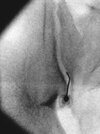Here are some images of an SI-J I did today.
This is on the right side - not a true AP. The fluorscope is tilted caudad (with reference to the detector, not the source) and contra-lateral. The caudad tilt brings the Posterior Superior Iliac Spine (PSIS) to (about) mid joint. Then, rotate contralateral (towards midline) until the two joint lines cross just under the PSIS. This will usually give a flashlight sign - meaning, you get a small square that lights up. This is your spot. It is extremely rare that if you line it up as such, that the needle doesn't slide in the joint.
View attachment 364962
The red line highlights the PSIS. The blue lines highlight the two joint lines as they cross right below the PSIS.
View attachment 364963
The lateral in this injection is not as far anterior as I would have liked to go. However, as mentioned above, doing these under CT has given me a much great appreciated for how these joint edges are - and sometimes, there is no way you can go further because of the jagged edges.
View attachment 364964



